486 Search Results for opportunities
December 21, 2012
by Carole Zangari -
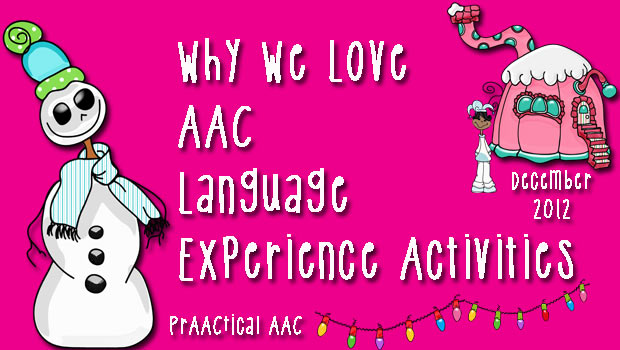
We love hearing the ways in which SLPs are using language experience activities in their therapy. That’s why we woke to big smiles today in hearing the story of a clinician who was having fun teaching the word ALL with goldfish crackers. Her little AAC friends could ask for a cracker and get one, or ask for ALL and get a pre-packaged portion. The power of contrast works in our favor in times like these. And it could easily be done with puzzle pieces or Lego blocks or any number of things. We can highlight it when we ALL leave the room or play a game as a group. Families can get in on the action, too. They can check to see if they have ALL the items from a list in the shopping cart or if they’ve put away ALL the groceries or laundry. Repetition with variety: another of... [Read More...]
December 17, 2012
by Robin Parker -
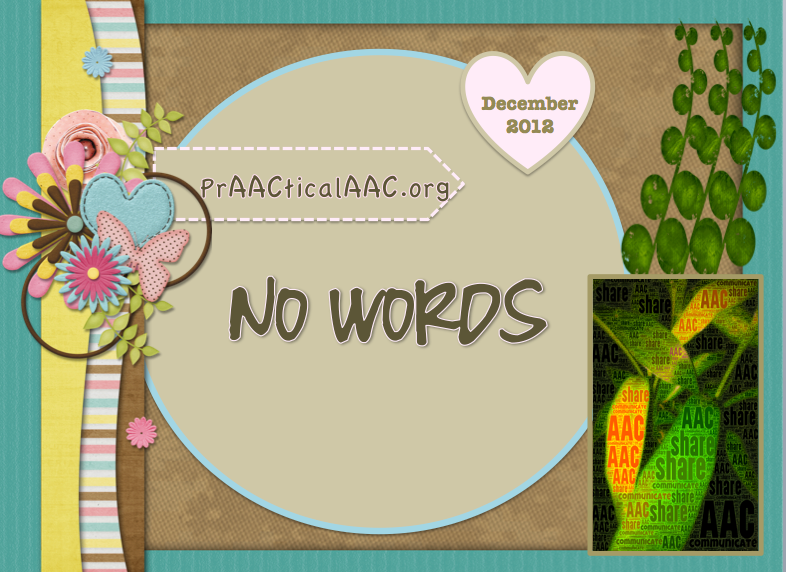
It’s been a long few days. Like everyone else, the Sandy Hook Elementary School Massacre has been on our minds, in our hearts, and in our dreams. We didn’t want to write about it. We didn’t even want to think about it. We have refrained from tweeting and ‘Facebooking’ about it. It’s all just too hard. Too sad. Too overwhelming. Too… Well, you know. But as the numbness started to wear off, we realized that we couldn’t avoid blogging about it. Why? Because it matters to people with AAC needs, too. And we, of all people, should understand that silence is not the answer. Unfortunately, we have been through other horrific world events and people who use AAC or communicate in other unconventional way have told us. “We’re hurting, too.” The SLP community has something to offer here and a responsibility to help where we can. As clinicians, we agonize. “What... [Read More...]
December 7, 2012
by Carole Zangari -

Last month, we talked a lot about semantic intervention with people who are learning AAC. Once we got started, we realized we could have done another whole month on the topic, but we had to move on. We ran out of time before we could really talk about outcome measures. As clinicians, how do we determine whether our therapy is effective? Here are some things to do after you’ve provided high-quality, well-sequenced vocabulary instruction. Make small comprehension checks a regular part of your instruction. Ask the AAC learner to tell you about ___ . Then score their response as objectively as possible (e.g., complete & correct, correct but incomplete, vague, incorrect). You’ll get some real-time feedback and can clarify or re-teach as necessary. Assess in a standardized fashion. Standardized means doing something the same way each time. Set up appropriate assessment tasks that allow you to judge how well the... [Read More...]
December 1, 2012
by Carole Zangari -

There’s something about the month of December that makes us a bit nostalgic. As we prepare for the holidays, our thoughts drift to the past. Simpler times. Tradition. The way things used to be. And, so, for our Strategy of the Month, we step away from the latest app or fanciest SGD and turn our attention to one of the tried-and-true tools from the past: Communication books. They used to be ubiquitous but now they’re becoming almost a rarity. We’ve decided to focus on them for a couple of reasons, but the main one is to spread the word that it doesn’t take a sizeable budget to give someone access to real language. If you have access to a computer and printer, you can make a really robust communication book for little or no money. It seems so simple: Put some words and pictures in a book. Show someone how... [Read More...]
November 24, 2012
by Robin Parker -
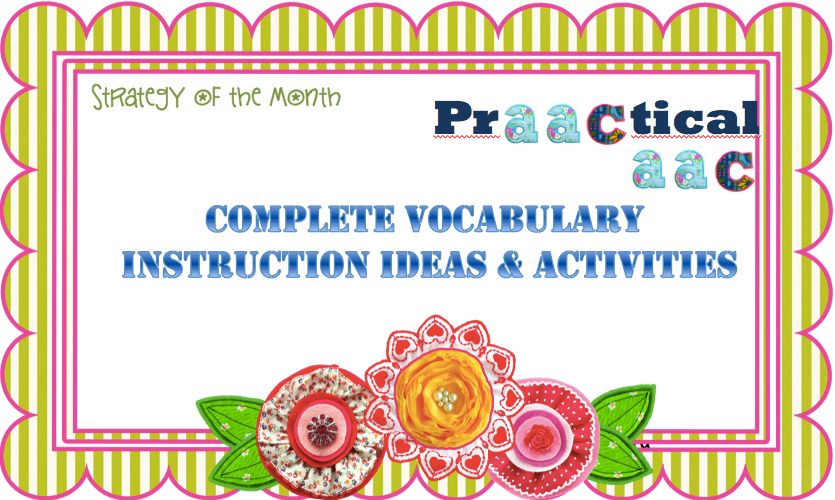
We love incorporating new vocabulary into fun motivating activities even when we are doing direct vocabulary instruction. We embed new vocabulary in activities using all of the language modalities- reading, writing, talking, and listening. We use planned vocabulary instruction activities as well as unexpected opportunities to embed new vocabulary. We like to stay within the theme of vocabulary learning but try and stay flexible in case a perfect opportunity arises that allows us to reflect back on an old vocabulary theme or mention a future planned theme. The main goal of direct vocabulary instruction is more than learning a new list of words, it is learning robust word knowledge so that language skills can be broadened. Consider these vocabulary instruction steps by Robert Marzano. These steps were not specifically developed for AAC users but if we add a language focus and a little more fun and active participation, they... [Read More...]
November 20, 2012
by Robin Parker -
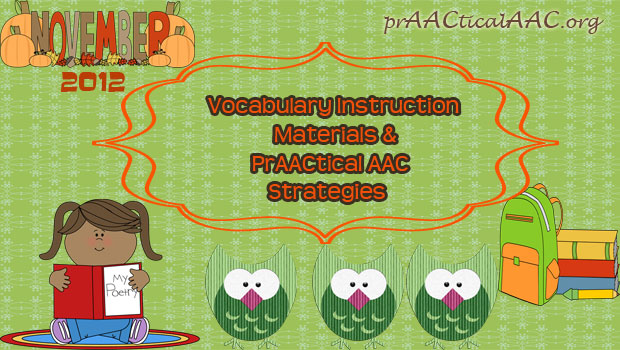
We are super big fans of Teachers Pay Teachers (TPT). We need the PrAACtical resources that TPT offers. In addition to paying ridiculously low prices for some great teaching materials and cool classroom resources, there are also many free options. Check out these free vocabulary resources and have lots of fun. As always, the materials are only as good as the teaching strategies that go with them. As we check out these awesome vocabulary resources, we will use the following guiding principles and we will create appropriate communication opportunities for ALL learners to participate in direct vocabulary instruction. Active Participation for Everyone– Make sure all learners can make choices within the activity, respond to questions, add information, request clarification, and even ask for a break if they need it. To do this we will need one hit message devices, visual supports, individual and group communication displays, choice boards, switches, etc.... [Read More...]
November 20, 2012
by Carole Zangari -
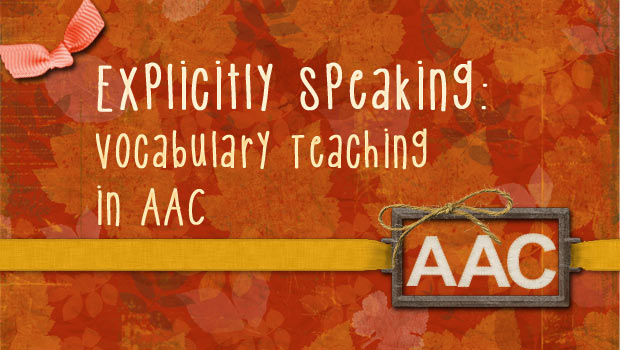
An essential part of the model we shared for AAC semantic intervention is Step 2, teaching the new words with explicit instruction activities. In our posts, explicit instruction refers to the process of designing and using carefully planned sequence of empirically-supported teaching activities. Though focused on reading, not vocabulary, development, this PowerPoint presentation by Dr. Anita Archer gives an excellent overview of the characteristics of explicit instruction. In our initial teaching of new words, we to be sure that the learners have frequent opportunities to respond: Active participation is critical at this point. We have to give the learner a lot of opportunities to say the word (e.g.,“resume”) and tell about it (e.g., “keep going,” “start again and not stop,” “verb”, etc.). We want to elicit a lot of responses so that we can monitor their performance. That allows us to provide feedback that is affirmative when the learners respond... [Read More...]
November 17, 2012
by Carole Zangari -
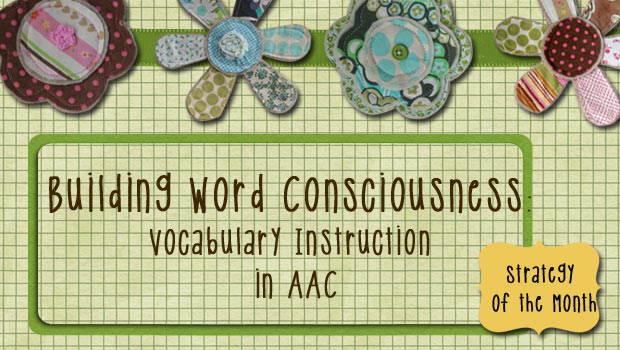
The mind is not a vessel to be filled but a fire to be kindled. Plutarch Last week, Robin discussed some strategies and activities for teaching new words to individuals who are at the earlier stages of language learning. This week, we move ahead and address semantic instruction for individuals who regularly create sentences to express themselves. One of my favorite things about working with AAC learners at this level is the opportunity for having metalinguistic conversations. Getting them to think and talk about language can accelerate their learning. Here are some prAACtical thoughts on how this relates to semantics with a focus on building word consciousness. We’re all familiar with music appreciation and art appreciation. I always think of word consciousness as a sort of like word appreciation. It refers to an awareness that words are the building blocks of language and that they can be examined and manipulated... [Read More...]
November 14, 2012
by Carole Zangari -
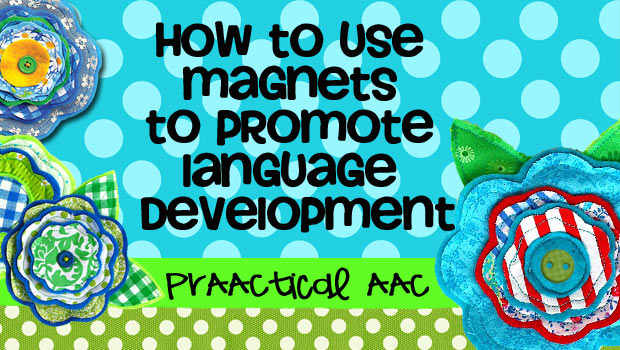
Want to help AAC learners accelerate their receptive vocabularies? Here’s one quick and easy step in the right direction: Talk to them. We’re not trying to be snarky here. The truth is that we speak less to people who are minimally verbal than we do to people who talk. In general, kids with AAC needs hear far less language than speaking children do. Fewer words heard means fewer opportunities to learn language. That’s a cycle worth breaking. When we’re around typically developing children, they’re always asking questions. “What’s in the bag, Mom?” “Why is she doing that?” “How come Billy gets to have one and I don’t?” “Where are we going?” “Are we there yet?” Kids ask lots of questions, particularly in the early years. Annoying? Sometimes. Valuable? Always. From a language learning perspective, those pesky questions serve a very useful purpose: they invite (or demand) a linguistic response. They... [Read More...]
November 13, 2012
by Carole Zangari -
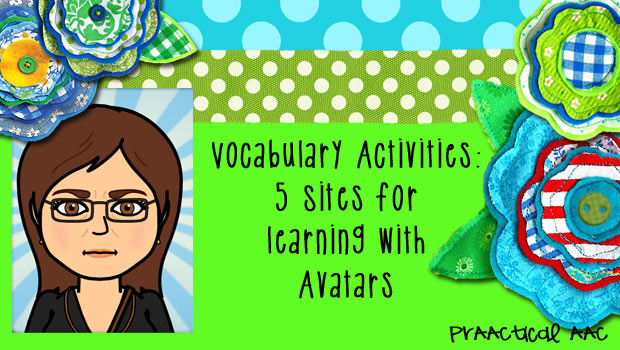
We’re always looking for engaging activities to use to practice words that our AAC friends are learning. For some learners, making avatars can be a great way to do have an authentic reason to use words for body parts and accessories as well as modifiers for size, shape, color, and other things. Plus…Who wouldn’t want an excuse to make a younger, thinner, cuter, or funnier version of themselves?! Here are some sites to check out. Pop Art Pixies: Basic avatar site oriented for girls. Good for using core language, making requests, color & size words. DoppelMe: Easy to use site for making cartoon-like avatars with several opportunities to choose elements, like clothes, hairstyles, and backgrounds. Use words for feelings to select facial expressions. WeeWorld: Another user-friendly site that can be a fun way to use descriptors in making selections to create, dress, and style your avatar. This site’s graphics would... [Read More...]








